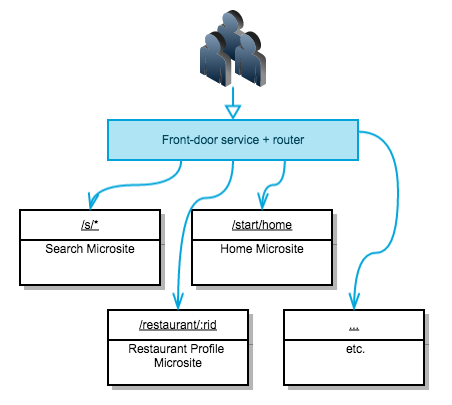Components as microservices
SOA in the front-end world
Matteo Figus / @matteofigus
@matteofigus
Coding, technology, conferences
London, UK
OpenTable

Restaurant Reservations - Free • Instant • Confirmed
more than 32K restaurants worldwide
more than 16M reservations every month
more than 450K reviews per month

Europe, North and South America, Asia
millions of requests per minute
more than 50 engineers make changes every day
Agenda
- Microsites architecture
- OpenComponents architecture
- Agile in the front-end world
The Microsites architecture
Step #1 - Dismantling the monolith
Continuous delivery in dates
2012 - Setup continuous integration pipeline
2013 - All the code moved to github
2014 - First project implements continous deployment
2015 - 10+ deployments per day
couple days ago - New engineer makes 1 PR and gets its code to prod on day 1
The monolithic architecture (2012)
- Unique giant DB managed by DBAs
- Stored procedures to handle data
- Huge .NET applications dialing directly with the DB
The monolith
Deployments every 15 days
Not very resilient
Not very robust
Code consistency (one single language)
Dedicated team for infrastructure
Dedicated team for testing
A couple of years later...

Microsites

www.opentable.com/san-francisco-restaurants
- "start" microsite
- San Francisco metro
- => http://start-123/?domain=com&metro=4
Microsites
- Team of 2 to 4 full-stack engineers
- Minimal complexity
- Minimal dependencies
- Easier to test, maintain, extend
- Multiple daily deployments
- Ownership
The common parts

The common parts

Microsite rendering (server-side)
- http://search-456/?metro=4&dateTime=2015-10-23T19:00
- Execute logic
- GET shared components from Components API
<html>
<head>
<!-- css component -->
<!-- js head component -->
...
</head>
<body>
<!-- header component -->
...
<!-- footer component -->
<!-- js body component -->
...
</body>
</html>
Components for common UI elements
$ curl http://components-789/header/1.X.X/?userType=Admin&metroId=72 -H Accept-Language:en-US
{
"href": "http://components-789/header/1.X.X?userType=Admin&metroId=72",aefaef
"html": "<div><img src=\"//srs.opentable.com/logo.jpg\" />...</div>"
}
Microsites + Shared components
Consistency
Coordination
Optimal front-end loading
Easy to spin-up new microsites
OpenComponents
A framework for developing and deploying HTML components
github.com/opentable/oc

Demo time!
Getting started
$ npm install -g oc
$ mkdir demo && cd demo
$ oc init test-component jade
$ echo 'div this is my component' > test-component/template.jade
$ oc dev . 3030
$ oc preview http://localhost:3030/test-component
Ship it!
$ oc registry add http://oc-registry.herokuapp.com
$ oc publish /test-component
$ oc preview http://oc-registry.herokuapp.com/test-component
Static resources? Let me handle this!
// template.jade
img(src=staticPath+'img/img.jpg')
// server.js
module.exports.data = function(context, cb){
cb(null, {
staticPath: context.staticPath
});
};
Client-side rendering
<html>
<body>
...
<oc-component href="http://oc-registry.com/component/1.X.X/?a=b">
</oc-component>
...
<script src="http://oc-registry.com/oc-client/client.js">
</script>
</body>
</html>
Server-side rendered components
$ curl http://oc-registry.com/hello-world
{
"href": "https://oc-registry.com/hello-world",
"name": "hello-world",
"version": "1.0.0",
"requestVersion": "",
"html": "<div>hello John Doe</div>",
"type": "oc-component",
"renderMode": "rendered"
}Server-side unrendered components
$ curl http://oc-registry.com/hello-world
-H Accept:application/vnd.oc.unrendered+json
{
"href": "https://oc-registry.com/hello-world",
"name": "hello-world",
"version": "1.0.0",
"requestVersion": "",
"data": { "name": "John doe" },
"template": {
"src": "https://s3.amazonaws.com/your-s3-bucket/components/hello-world/1.0.0/template.js",
"type": "handlebars",
"key": "cad2a9671257d5033d2abfd739b1660993021d02"
},
"type": "oc-component",
"renderMode": "unrendered"
}Server-side rendering with node.js
npm install oc-client --save
var Client = require('oc-client'),
client = new Client({
registries: {
serverRendering: 'http://oc-registry.intranet/'
clientRendering: 'http://oc-registry.com/'
},
components: {'hello-world': '~1.0.0'}
});
client.renderComponent('hello-world', function(err, componentHtml){
console.log(componentHtml); // => rendered html
});
Features
Enables people to create and publish new components independently
Granular ownership
Performances
Robustness
Serve as framework for experimenting and A/B testing new ideas in the front-end
Microsites have control
What is a microservice?
Good question, dear
The art of destroying software
https://player.vimeo.com/video/108441214
Why are you doing this?

Ownership

Microservices / Microsites / Microteams
- Minimal dependencies
- Minimal complexity
- Closer to Business
- Trusted to handle ownership
- Optimised for resilience
Conclusions
SOA is not just about code
Test, test, test
Failure is a feature
Componentise all the web!
Thank you
http://tech.opentable.co.uk/blog/2015/02/09/dismantling-the-monolith-microsites-at-opentable/
github.com/matteofigus/oc-components-examples
follow me on twitter - @matteofigus
 @matteofigus
@matteofigus